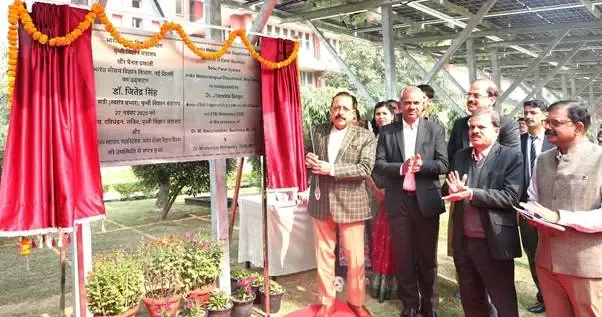What Are the Three New Initiatives Launched by the Centre for Weather Forecasting?

Synopsis
Key Takeaways
- Two new Doppler Weather Radars launched to enhance weather forecasting.
- Meteorological Museum established to inspire future generations.
- Solar power system installed to support clean energy initiatives.
- IMD aims to achieve over 50% radar coverage by 2027.
- Future plans include urban and advanced radars in strategic locations.
New Delhi, Nov 27 (NationPress) On Thursday, the Union Government unveiled three significant projects from the India Meteorological Department (IMD) -- two advanced Doppler Weather Radars (DWRs), a newly established solar energy system at Mausam Bhawan, and a Meteorological Museum.
Dr. Jitendra Singh, the Union Minister of State (Independent Charge) for Science & Technology, who initiated these programs, highlighted that the IMD is swiftly moving forward with the ambitious ‘Mission Mausam’, which was dedicated to the nation by Prime Minister Narendra Modi during the IMD’s 150-year anniversary celebration in January.
“We promised to increase the radar count from 47 to nearly three times by 2027, and I am pleased to announce that we have already reached 126 radars within a few months. We still have two years left, and I am confident that we will not only meet but exceed this target ahead of schedule,” Singh stated.
The dual-polarised, solid-state power amplifier-based C-Band Doppler weather radar, located at Indira Gandhi Krishi Vishwavidyalaya in Raipur, Chhattisgarh, is capable of detecting monsoon depressions, low-pressure systems, heavy rains, thunderstorms, lightning, hailstorms, squalls, and turbulence over a range of 250 km.
This radar's observational capacity spans Chhattisgarh, interior Odisha, eastern Madhya Pradesh, southwestern Jharkhand, and the southern areas of East Uttar Pradesh, effectively bridging a significant data gap and substantially enhancing IMD’s forecasting abilities in these territories.
The second radar, situated at the IMD’s RS/RW Office in Shakthi Nagar, Mangaluru, Karnataka, will facilitate sophisticated monitoring of severe weather phenomena such as cyclones, thunderstorms, squalls, heavy rainfall, lightning, hailstorms, and turbulence.
With a 250 km coverage area, this radar will observe the Arabian Sea near Karnataka, regions of Goa and South Konkan, northern Lakshadweep, and the land areas of Karnataka, Kerala, Goa, and South Maharashtra.
The newly established Meteorological Museum aims to inspire students, researchers, and the youth by showcasing the IMD’s 150-year legacy.
This museum will exhibit historical weather instruments, upper-air observation systems, communication tools, radar and satellite components, and will provide audio-visual resources for an interactive learning experience.
Singh encouraged the IMD to organize structured educational tours for students, describing the museum as a “journey through a century of scientific advancement.”
In line with India’s clean energy goals, the IMD has also installed a 771 kWp solar power system at the Mausam Bhawan Complex, featuring 1,315 solar panels set up through NBCC.
Singh emphasized that this initiative aligns with national objectives under the PM Surya Ghar Muft Bijli Yojana, supports India’s commitments to achieving net-zero emissions, and serves as a model for other government facilities.
“IMD has now accomplished over 50 percent radar coverage and is planning to add more radars, including urban radars in Delhi, Chennai, Mumbai, and Kolkata, as well as advanced phased-array radars for the Himalayan regions of Jammu and Kashmir, Uttarakhand, and Himachal Pradesh,” stated Dr. M. Ravichandran, Secretary of the Ministry of Earth Sciences.









